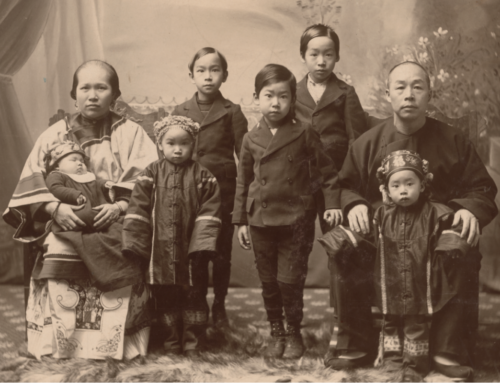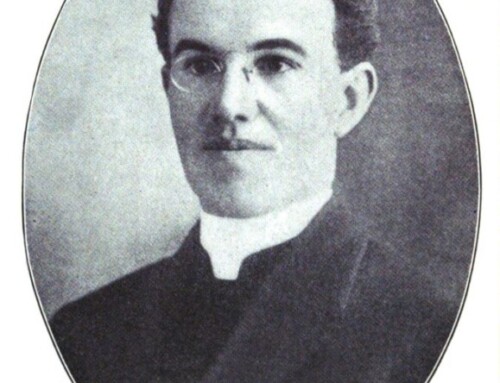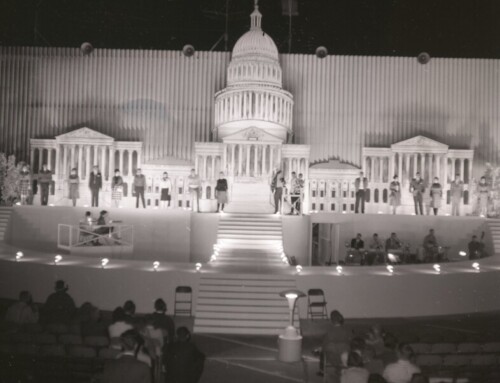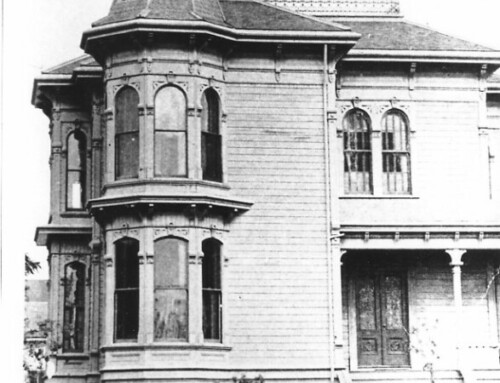Mellow Moon Pavilion was built the summer of 1925 by owners Mills and Albright at the west end of the Marion-Polk county bridge in West Salem. A ten dollar prize for the best name submitted was awarded to Mrs. Alma V. Henderson of Chemawa. The name was selected for its reference to the popular “Mellow Moon” waltz and, according to the owners, “because it fit the soft lights that were already installed.” The popular dance hall was nestled in a beautiful spot along the west bank of the Willamette River just south of the bridge at 554 Edgewater St., which on a current map would place it southeast of present day Westside Station Restaurant and Nightclub, underneath Highway 22.
David Eyre, one time managing editor of the Capital Journal newspaper recalled his Saturday nights as a youth in the early 1930s being spent meeting friends, piling into jalopies to go across the river to the Mellow Moon where there “was a lot of necking in cars along the river and a lot of moonshine consumed behind the cars.” Open Wednesday and Saturday nights with an admission price of ten cents for ladies and fifty cents for gentleman the dance hall featured popular bands and orchestras such as Jack Bell and His Melody Pirates that would travel the dance hall circuit across the country.
The Mellow Moon changed ownership and purpose throughout the years eventually becoming a roller skating rink under the ownership of Mr. and Mrs. Charles C. Hansen from 1939 to 1942. In fact, the final payment on the business loan was made just a few weeks before the fateful night of New Year’s Eve 1942. What should have been cause for celebration instead became a great tragedy to all involved.
New Year’s Eve fell on a Thursday night in 1942 and while some Willamette Valley residents celebrated, others kept an anxious watch on river levels. Anticipated to be the worst flooding since 1923, damage reports and deaths were already being reported by communities further south in the river’s path. Walter Gerth, West Salem merchant and downtown neighbor of the Mellow Moon who had been through every Willamette flood since 1890 went out on a limb, predicting that “little damage would be caused except possibly to lowland farm improvements,” when interviewed by an Oregon Statesman reporter. As the clock passed midnight, the river level stood at 22.2 feet.
As the next morning dawned, Charles Hansen checked on the Mellow Moon and found water flowing several inches over the floor. The building was inspected by engineers at his request and assurance given that it would stand secure in the rising tide. After all, it had survived floods in the past. By 1 p.m. Friday afternoon the river gauge read 27.5 feet and the water was gaining at the rate of 3 inches an hour. Evacuations had begun in the lowlands north and south of Salem. Fifteen minutes after Hansen left for the day, the little bridge connecting the Mellow Moon to Edgewater St. washed away.
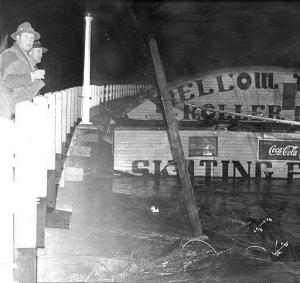
Mellow Moon Skating Rink against the bridge during January 1943 flood. Photo Credit: Salem Public Library – Ben Maxwell collection
At approximately 6:30 p.m. that evening, the old Mellow Moon rose from its foundations and swept north in the river current slamming into the west approach of the Marion-Polk county bridge. It tore out one bent in the timber piling support from beneath the structure and damaged three others. Holes were broken in the boardwalk and the roadway dipped a foot or more in two places, but did not tilt. Toppled into the river by the impact of the building and pulling wires across the bridge, was one of the high feeder line poles of Salem Electric adding to the hazard. At 10:30 p.m. log rafts from the Oregon Pulp & Paper Mill broke loose and hit the Mellow Moon. The skating rink was close to the breaking point but the bridge stood solid.
Governor Charles A. Sprague directed the highway department to take all possible steps to save the bridge, dynamiting the Mellow Moon building if necessary. R.H. Baldock, chief highway engineer expressed his confidence that the bridge would stand during the night. “We are going out at daylight and try to tear it down or blow it up.”
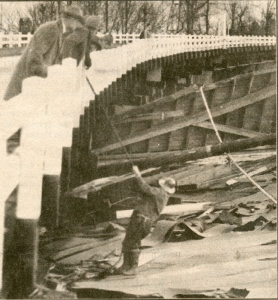
Jerry Farrar, superintendent for the highway department examines the wreckage of the Mellow Moon Skating Rink. Photo Credit: Statesman Journal – Al Lightner photographer
With the river cresting at 30.5 feet Saturday morning, January 2nd, a 12 man state highway crew went to work using dynamite and cables, expecting to have the debris cleared away in a few hours. At 10:30 p.m. that night the wreckage finally broke apart and headed downstream beneath the shorn bridge piling. Here the story diverges slightly. The Capital Journal reported that nine of the twelve men standing on the dance floor scrambled up ladders and cables to the bridge deck and safety, with three men plunging into the river. The Oregon Statesman reported four men; one was thrown a rope and pulled back to the bridge while the other managed to save himself by clinging to a piece of wreckage that lodged against the railroad bridge several hundred yards downstream. However, both papers agree that two men did not make it, Archie Cook of Woodburn, and Michael Mauer of Stayton. None of the men wore life-belts.
With the help of librarian Laura Wilt of the Oregon Dept. of Transportation Library, online newspapers, Ancestry.com and descendants of both men we were able to piece together a few more clues about these two heroes who gave their lives to save the bridge. In 1943, Michael J. Mauer was a truck driver assigned to the highway maintenance crew. Born February 1, 1910 in Topeka, Kansas, he was the son of Russian immigrant Joseph G. Mauer and Mary Kammer. After the death of his father and remarriage of his mother to Joseph J. Lambrecht, the family moved to Oregon in the 1920s. Just prior to the 1940 census he married Carmelita Grooms. At the time of his death, she was pregnant with their only child. The nine pound baby girl would be born 8 months later. Michael was buried in the St. Mary Catholic Cemetery in Shaw, Oregon. He was 27 years old.
Archie A. Cook was a section foreman helper for the highway department. His ODOT record states that he went into the river first, at 10:25 p.m., five minutes before co-worker Michael. Archie was born October 10, 1907 in La Center, Washington to Edwin Cook and Eva Jean Green. His mother passed away when he was 10 years old. He moved to Woodburn, Oregon in 1930 after his marriage to Helen Frentz. Two children were born to the couple: Jack and Jimmy. The boys were 12 and 8 respectively at the time of their father’s death. He was buried in Belle Passi Cemetery in Woodburn, Oregon. Archie Cook was 33 years old.
The water receded, damages were tallied, the bridge repaired and opened a week later, and the Hansens would go on to open another skating rink in Salem on the other side of the bridge. But life had changed forever for the families of these two men who were on the front line to protect the lives and property of their fellow citizens.
This article was written by Kaylyn F. Mabey for the Statesman Journal where it was printed 17 January 2016. It is reproduced here for reference purposes.
References:
- “Mellow Moon Pavilion Opens” Capital Journal (Salem, OR) – July 7, 1925
- “Red Cross Unit Alerted; Lower Areas Swept” Oregon Statesman (Salem, OR) – 1 January 1943
- “Building’s Floor Breaks, Drops Highway Crew” Oregon Statesman (Salem, OR) – January 3, 1943
- “When the flood took Salem” Statesman Journal (Salem, OR) – January 2, 1996
- Newspapers.com – Oregon Statesman & Capital Journal issues Dec 31, 1942 – Jan 7, 1943
- Elsie Jory scrapbook – WHC
- Al Black poster WHC 2014.082.0331
- Aeriel photographs of West Salem after flood damage WHC 2011.030.0044
- http://bridgehunter.com/or/marion/center-street/
- ODOT Library and highway department fatalities catalog records



